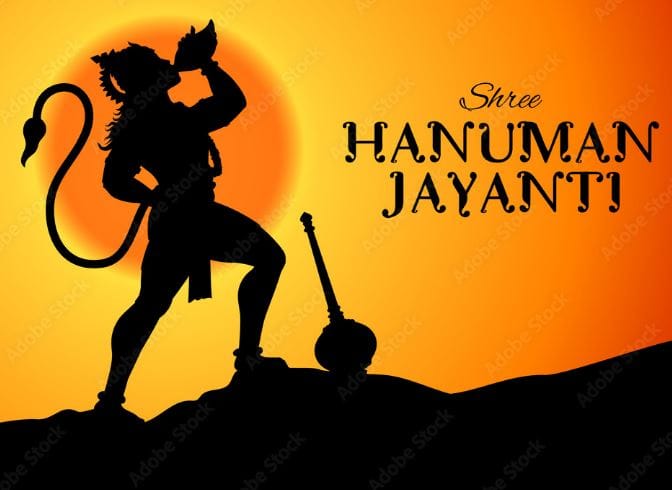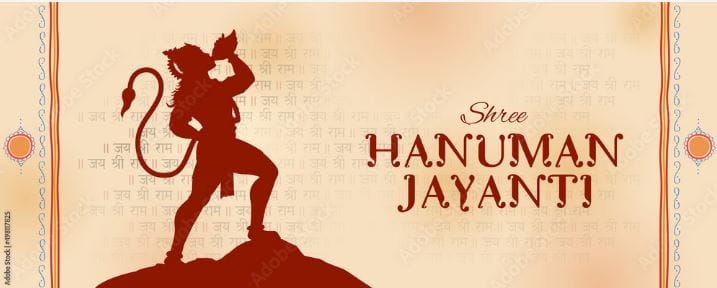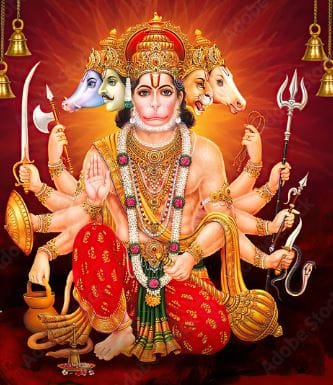The Hindu community celebrates Hanuman Jayanti as a renowned festival which honors the birth of Lord Hanuman who embodies devotion together with strength and selfless service. People throughout India celebrate this festival annually with great passion because it has enormous spiritual value to millions of followers. Lord Hanuman presents through his devotion to Lord Rama and remarkable feats in the Ramayana an example of fearless loyalty. The article examines Hanuman Jayanti through comprehensive research which includes historical background alongside significant traits and the performing rituals and various regional expressions and cultural transformations of this festival.

👉Historical Significance :-
⏩The Birth of Hanuman :-
The origin of Lord Hanuman’s birth comes directly from Hindu religious beliefs. The Valmiki Ramayana mentions how Anjana and Kesari conceived Hanuman. The celestial being Anjana who had turned into human form made intense prayers to Lord Shiva for a boy who would worship Lord Vishnu. A divine response came to her when Vayu Dev blessed her with a child who possessed extraordinary divine powers. Lord Shiva granted his divine powers to Vayu Dev so the Wind God became the father of Hanuman who received the name Pawan Putra (Son of Wind) before his birth as an incarnation of Shiva.
The birth story of Hanuman happened during Treta Yuga on Chaitra Purnima which marks the full moon day of the Hindu month of Chaitra. Hanuman Jayanti marks the celebration of this fortunate occasion.
👉Significance of Hanuman Jayanti :-
⏩Devotion and Strength :-
Lord Hanuman stands as the perfect example of complete devotion toward Lord Rama. Devotees honor his selfless dedication and loyalty because these qualities represent virtues that they wish to develop. During the Ramayana Hanuman demonstrated outstanding strength together with intelligence and courage to help Rama defeat Ravana. The deity represents both determination together with religious faith which allows people to face all obstacles in their path of life.
⏩Spiritual Teachings
During Hanuman Jayanti people remember to practice spiritual principles which combine devotion with dedication and surrender to divine plan. People who venerate Lord Hanuman ask for his divine protection against spiritual threats while asking for direction during their spiritual development.

👉Rituals & Celebrations :-
⏩Preparations for Hanuman Jayanti :-
Devotees follow the early morning tradition of ritual washing on Hanuman Jayanti by taking a bath. The celebration day includes religious observance through fasting while carrying out devotional acts focused on Lord Hanuman. People decorate their houses and temples with flowers along with vermilion to represent the powerful nature of Hanuman.
⏩Puja Vidhi (Worship Rituals) in Hanuman Jayanti :-
⇒Sankalp :- During Sankalp devotees make a vow by holding water as they think about Hanuman’s admirable qualities.
⇒Offerings :- As part of Panchamrit Abhishek ritual the devotees bathe the idol or picture of Lord Hanuman with milk and curd followed by honey and sugar and ghee. Vermilion paste (Sindoor), flowers, bananas, laddoos and halwa are among the foods offered to the deity during worship.
⇒Mantras :- The sacrament of chanting powerful mantras includes the recitation of “Om Shri Hanumate Namah” and the Hanuman Chalisa which contains forty verses honoring Lord Hanuman’s characteristics.
⇒Ram-Sita Worship :- Worship of Lord Rama and Sita occurs during prayers because Hanuman remains devoted to the divine couple.
⏩Processions and Community Feasts :-
Devotees organize ceremonial parades in numerous areas to perform bhajan devotional songs while they honor Lord Hanuman. The community organizes communal feasting events through which people unite as brothers by sharing their meals.
👉Regional Variations in Celebration for Hanuman Jayanti:-
⏩North India :-
The people of Uttar Pradesh and Bihar along with Bihar celebrate Hanuman Jayanti on the full moon day of Chaitra by visiting temples and reading the Ramayana. Devotees from all walks of life visit Sankat Mochan Temple in Varanasi to receive blessings from the temple.
⏩South India :-
Karnataka along with Andhra Pradesh use local calendars to determine the dates for the festival celebration. Anjaneya temples conduct special prayers for Lord Hanuman which honor his relationship to local religious customs.
⏩Odisha :-
Hanuman Jayanti in Odisha falls at the same time as Pana Sankranti which marks the Odia New Year. Worshippers simultaneously give pana (sweet drink) while performing their devotions.
⏩Tamil Nadu & Kerala :-
The festival takes place in Margazhi month of December-January across both Tamil Nadu and Kerala. The religious practice includes devotees who perform chanting of Sundara Kandam from the Ramayana.
👉Cultural Impact of Hanuman Jayanti :-
⏩Literary Contributions :-
Lord Hanuman found eternal recognition within the Hindu religious texts including Ramayana and Mahabharata and diverse Puranas. Devotees widely embrace the Hanuman Chalisa hymn which Tulsidas penned as one of their most beloved religious texts.
⏩Artistic Representations :-
The tales of Hanuman have motivated numerous artistic works where paintings showcase his heroic actions such as moving Mount Dronagiri and burning Lanka with his tail.
⏩Modern-Day Relevance :-
The character traits of Hanuman continue to find relevancy in present-day society.
⇒People turn to Hanuman for strength because he gives them faith when difficult times arise.
⇒His devotion teaches humility.
⇒His wisdom encourages thoughtful decision-making.
👉Global Observance of Hanuman Jayanti :-
The Indian festival of Hanuman Jayanti has spread its recognition across Hindu communities throughout the world.
⇒Nepal and Sri Lanka along with other nations that connect to Ramayana conduct special prayers on this occasion.
⇒Hanuman Jayanti celebrations take place as cultural events in religious temples across Mauritius and Indonesia as well as Trinidad & Tobago.
⇒During their celebrations Indian communities in diaspora organize communal singing of hymns at their events.
👉Challenges in Modern Observance for Hanuman Jayanti :-
Despite its popularity:
⇒People have decreased their involvement in traditional religious ceremonies because of urban development.
⇒Commercialization sometimes overshadows spiritual essence.
⇒Environmental problems occur because large-scale processions produce substantial waste.
People from religious groups make active efforts to maintain religious observance along with adopting environmentally responsible practices.

👉Riruals on Hanuman Jayanti :-
On Hanuman Jayanti people engage in different religious practices to praise Lord Hanuman and ask for his divine intervention. Followers perform the essential practices during Hanuman Jayanti celebrations.
⏩Early Morning Bath & Preparations :- Devotees begin their day by cleaning themselves with water and putting on new clothes. Devotees prepare the worship space by cleaning it and adding decorations with flowers and rangoli items.
⏩Temple Visit :- People who admire Lord Hanuman make temple visits to worship and ask for his blessings while putting vermilion from his idol on their foreheads.
⏩Puja Vidhi (Worship Rituals) :-
⇒Sankalp Mantra :- Devotees make a promise to perform complete worship of Lord Hanuman throughout the day.
⇒Abhishek :- During the Abhishek ceremony people bathe the idol using milk, yoghurt, honey, ghee and sugar. Devotees give vermilion paste along with flowers and clothes plus scent and offerings.
⇒Offerings :- Devotees provide jaggery, spices, red petals, jasmine oil, confectionery (boondi and besan laddoos), and fresh produce.
⇒Recitations :- Devotees worship Lord Hanuman through mantra chanting of “Om Shri Hanumate Namah” while reciting either the Hanuman Chalisa or Sundarkand.
⏩Aarti :- Devotees use ghee or jasmine oil lamps to perform Aarti as an act of religious devotion.
⏩Fasting :- Devotees practice spiritual discipline by refraining from eating food during the day.
⏩Charity :- On this day people should give assistance to others through actions such as sharing food with monkeys or providing donations.
People perform these rituals because they want to show their respect for Lord Hanuman and his powerful dedicated acts.
👉Significance of Monkey in Hanuman’s Mythology :-
In Hindu mythology Hanuman’s monkey body stands for both spiritual beliefs and practical benefits related to his holy purpose.
⏩Symbolism of the Monkey Form :-
⇒Humility & Devotion :- The monkey shape shows Hanuman’s basic nature and humility showing that true greatness comes from serving others not from external features. Through his devotion to Lord Rama Hanuman proves that inner goodness matters more than physical traits.
⇒Connection to Nature :- The Vanara designation of Hanuman shows how he lived in harmony with nature by representing environmental balance.
⇒Spiritual Lesson :- His spiritual lesson shows that a pure soul dedicated to devotion becomes spiritually important regardless of physical attributes or species.
⏩Practical Advantages of the Monkey Form
⇒Extraordinary Abilities :- Through his monkey form Hanuman gained extraordinary powers that let him move with superhuman strength and speed also exceed normal human stamina. Through his monkey form he could jump extreme distances fly between lands and create fire from his tail during the Ramayana events.
⇒Adaptability in Challenges :- As a monkey Hanuman gained unique abilities that let him shift his shape and connect with animals and nature to help Lord Rama reach his goals.
⏩Mythological Context :-
⇒Divine Purpose :- The gods chose Hanuman’s monkey identity to serve important duties during Lord Rama’s battle against Ravana. Brahma’s blessing made Ravana immune to humans and animals so Hanuman needed to take this specific form to fight against him.
⇒Curses & Blessings :- When young Hanuman create trouble his monkey form received certain restrictions that deactivated his abilities until Jambavan reminded him at key moments during the Ramayana epic.
The physical transformation Hanuman experienced became more than just a body change as it represented his deep devotion along with his capabilities and spiritual knowledge.
👉Reciting Hanuman Chalisa :-
On Hanuman Jayanti people benefit from both spiritual development and practical benefits when they say the Hanuman Chalisa. The forty-stanza Lord Hanuman hymn known as Hanuman Chalisa emerged from Goswami Tulsidas’s artistic mind to honor Hanuman’s mighty attributes. People believe that chanting the Chalisa on this day can bring Hanuman’s divine protection against difficulties and harmful energies including Saturn and Mars.
The devotional chanting helps people relax their minds and creates spiritual growth while making their anxiety fade away. Being dedicated to the Chalisa develops strong faith and spiritual power to deal with life’s difficulties and strengthens our bond with God.
👉Famous Temple for Lord Hanuman :-
In India many important temples celebrate Lord Hanuman through their special backgrounds. Here are several highly recognized temples dedicated to Lord Hanuman.
⏩Jakhoo Temple, Himachal Pradesh :- The temple sits at 8,054 feet above sea level and people visit it for its 108-foot high Lord Hanuman statue plus breathtaking scenery.
⏩Sankat Mochan Hanuman Temple, Varanasi :- Goswami Tulsidas established this temple which people visit because they believe it can take away their difficulties and the building design stands out.
⏩Hanuman Garhi, Ayodhya :- This 10th-century temple stands at the location where Hanuman defended the birthplace of Lord Rama.
⏩Bala Hanuman Temple, Jamnagar :- Since 1964 devotees have been conducting non-stop recitations of “Sri Ram, Jai Ram, Jai Jai Ram” at the temple and this achievement is recognized by Guinness World Records.
⏩Bade Hanuman Ji Temple, Allahabad :- Devotees can see 20 feet of Hanuman reclining in the water beside the Ganga River.
⏩Hanuman Mandir, Connaught Place, Delhi :- This temple located at its own source emerged when the Pandavas built it.
⏩Kashtbhanjan Hanuman Temple, Sarangpur :- The temple serves as a main pilgrimage destination because people come here to honor Hanuman for removing their troubles.
⏩Mehendipur Balaji Temple, Rajasthan :- People visit the temple to receive treatment from Hanuman Ji against spirit-related problems.
⏩Salasar Dham, Rajasthan :- At this temple people venerate a distinctive bearded Hanuman idol which a farmer supposedly found.
⏩Hanuman Dhara, Chitrakoot :- The temple sits on a cliffside where you can experience both mental peace and scenic beauty.
The temples draw huge crowds of people who come here to find religious favor and spiritual improvement.

👉Conclusion :-
Hanuman Jayanti represents more than a festival because it honors eternal values which include devotion and courage alongside humble service and devotion. People from millions of households annually unite to commemorate Lord Hanuman by performing religious ceremonies and devotions which strengthen their belief in sacred principles leading people toward right conduct.
On April 12th of 2025 we will celebrate this auspicious day with devotion to Lord Hanuman by following his teachings of facing challenges with strength and staying dedicated to our life’s purpose—a sacred tribute to the divine hero who continues to motivate countless people today.
💬Disclaimer :-
This Blog provides general information as an educational source only. The author uses their life experiences together with personal viewpoints to create all content. The author accepts no responsibility for damages or losses when users apply this information. The website information depends on your individual acceptance of personal risk when you use it. The information does not serve as professional guidance, so readers need to seek proper professional advice before implementing decisions from the provided content.